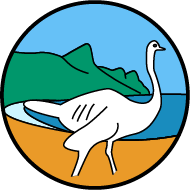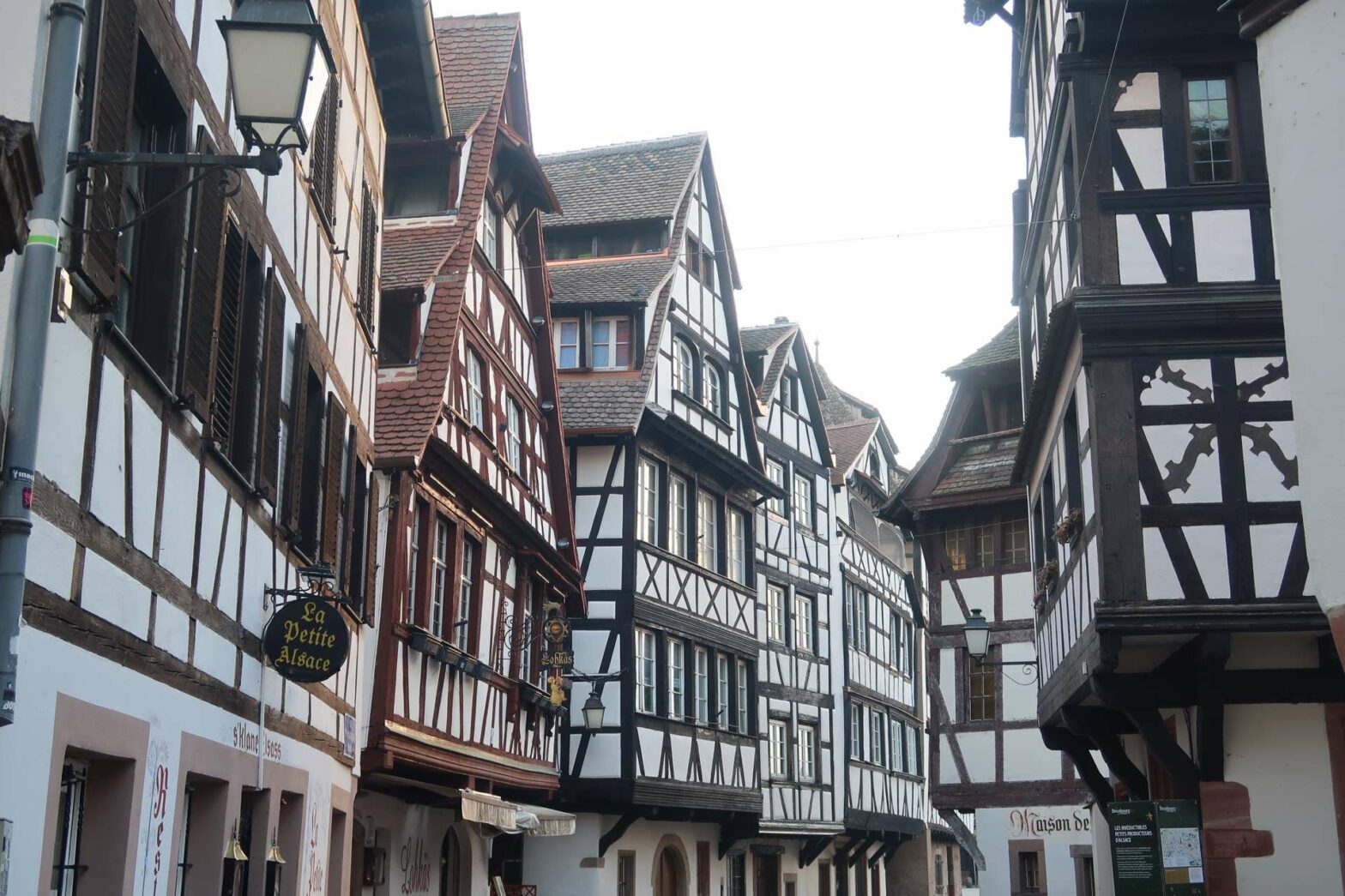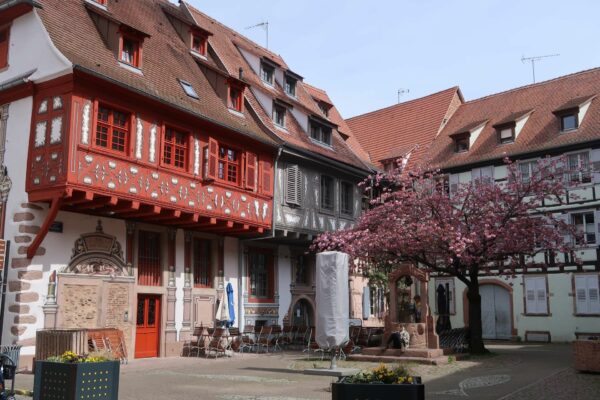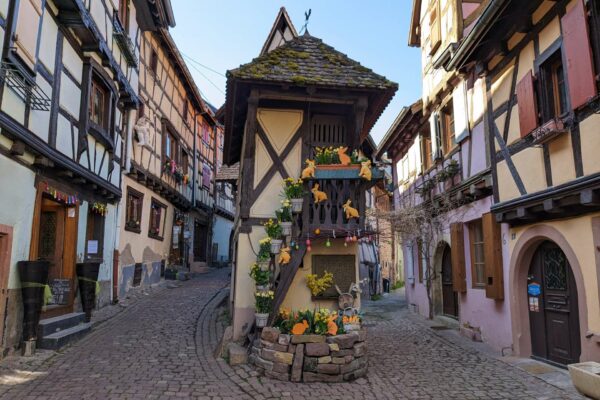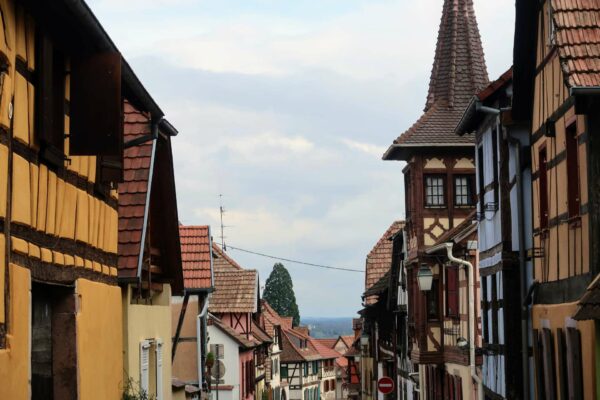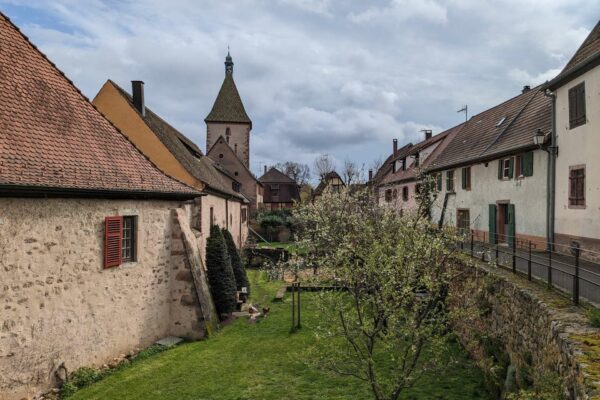By Vicky · Published Mar. 23rd, 2023 · Updated Apr. 3rd, 2024
When you buy through links highlighted with an asterisk (*) on this site, we may earn a small affiliate commission at no cost to you.
On this self-guided walking tour of Strasbourg explore the town’s narrow, winding lanes, cute wooden buildings, and visit the top museums. The first walk explores the city centre, while the second follows canals to the EU buildings, parks and more.
Page Contents:
Location
Both walking tours start from Saint Peter’s Catholic Church, about 300 metres from Strasbourg train station. It’s the first building you reach on Strasbourg’s Grande Île after crossing the river.
Strasbourg Walking Tour Map
Get the route by downloading the .gpx or .kml file below. For navigation with Maps.me on your mobile phone, simply download the .kml file and open to add it to the Maps.me bookmarks.
Tips for Strasbourg Walking Tour
- At the tourist office (open daily 9 am–1pm and 2–5 pm), you can get a Strasbourg City Card for discounts on museums and attractions, valid for 7 days. It’s only €5/3 for adults/kids and if you go up the cathedral tower plus visit a museum it’s already worth it.
- You can find a list of museum opening times here. Note that most are closed over lunch (1-2pm) and some are closed Tue & Thu, while others are closed Mon & Wed.
- Some museums have a free audioguide but they are not widely advertised so ask at the front desk.
- Many museums are free on the first Sunday of each month.
- Winstubs, or taverns, serve traditional food and drink such as choucroute (sauerkraut) and tarte flambée
- For more walking tours and hikes, see our France Hiking Page.
Top Sights in Strasbourg
On these self-guided walking tours you’ll see the main sights and attractions of Strasbourg. You can see everything in a rush over one day, but two days is the perfect amount of time to spend in Strasbourg.
- St Peter’s Catholic Church
- Petite France
- Musée d’Art Moderne et Contemporain
- Cave des Hospices de Strasbourg
- Alsatian Museum
- Historical Museum
- Cathedral Notre Dame
- Palais Rohan
- Grande Île
- Strasbourg Canals
- Neustadt
- EU buildings
- Parc de l’Organgerie
- University Campus
- Strasbourg Opera House
- St Peter’s Protestant Church
Apart from a walking tour, one of the best things to do in Strasbourg is to take a sightseeing boat tour (45 minutes from €14.90/8.25, small reductions with the Strasbourg City Card). There’s a commentary in several different languages of the sights that you pass. You can buy tickets and get on the boat by the river near the cathedral.FCave
Strasbourg Walking Tour Route 1: City Centre
This walking tour starts from St Peter’s Catholic Church.
1. St Peter’s Catholic Church
St Peter’s Catholic Church*, or St Peter the Elder’s Church (free entry, open 9am-7pm), is actually made up of two churches joined to each other. One section is for Catholics to worship and one is for Protestants, and the two bell towers represent the different faiths. The oldest parts of the church date back to the 13th century, and the newest ones to just after the Second World War, when many stained glass windows had to be replaced).
Inside it’s slightly plain but there’s a nice organ and paintings relating to the Passion of Christ. These date back to around 1480.
Directions: Walk around the church and left down the pedestrianised street (Grande Rue). Take the third street on the right (though second or fourth is also ok) then left at the T-junction.
2. Petite France
Petite France* is the name of the area on the western side of the Grande Île. This picturesque neighbourhood is known for its charming 16th-century half-timbered houses, canals, and quaint bridges. It’s the perfect place to take some photos and enjoy the atmosphere. It’s definitely not to miss on a walking tour of Strasbourg. A stroll through this area in the early mornings before the crowds arrive when it’s peaceful and quiet is a good idea. Sunset from the bridges and evenings are also nice. The Barrage Vauban and the Ponts Couverts are definitely worth walking across.
Directions: Walk along the street closest to the river then turn right at the square across the Pont Rue du Saint Martin. head straight onwards until a main road and turn right to the Barrage Vauban.
Barrage Vauban
The Barrage Vauban* (free, open daily 9am-7:30pm) is one of Strasbourg’s historical landmarks. It was built in the late 1600s as both a covered bridge and a defensive fortification. Today there’s a gallery inside and you can walk across its roof for panoramic views of the city and the Ponts Couverts. It’s a lovely place at sunset.
Directions: On the other side of the bridge, walk through the square and turn right (Stop 3 is on your left). Take another right and cross the Pont de l’Abattoir before heading right to the Ponts Couverts.
Ponts Couverts
The Ponts Couverts* (Covered Bridges) are a group of three bridges and four towers constructed in the 13th century, making them some of the oldest structures in Strasbourg. Take a leisurely stroll across the bridges and enjoy views of the Barrage Vauban across the still water. Historic buildings line the canals on the other side. As their name suggests, the bridges used to be covered by a wooden roof to serve as protection for defenders who occupied the bridge in times of war. The roofs were removed way back in 1784 but the name has remained since.
Directions: Return towards the start of the bridge and walk right down the side of a pretty waterway. Turn right at the end, then left back across the Pont Rue du Saint Martin. Turn right to walk along the river’s edge.
At the next bridge you’ll see Église Saint Thomas on your left, a protestant church with parts dating back to the 1100s. Inside there’s a large nave, a marble mausoleum of the Count of Saxony and a huge organ at the back.
Directions: Cross the bridge and turn left on the other side, then right heading away from the river. Make your way through the hospital buildings, heading left, right, then left, right again. Look out for the Wine Cellar, Stop 4, as it’s slightly hidden. You’ll see an unlikely-looking staircase with an old sign above leading down to the entrance.
3. Musée d’Art Moderne et Contemporain
Key Information: Open Tue & Thu-Sun, 10am-13pm & 14-18pm. Tickets are €7.50/3.50. Closed on Mondays and Wednesdays.
The Musée d’Art Moderne et Contemporain (Website, Tripadvisor Reviews*) is in a unique building, made of glass and steel in cube shapes. The museum is not very large and takes about 1-2 hours to visit. The collection includes fine art, photography, modern art and some great temporary exhibitions. There are works by Picasso, Monet, Kandinsky and more, along with local artists. The lovely Art Cafe overlooks the river from the first floor and serves great food. One drawback is that the labels are mainly only in French, not English, so you can’t fully engage with the pieces.
4. Cave des Hospices de Strasbourg
Key Information: Cellar and shop open weekdays 8:30-12:00 & 13:30-17:30, open Sat 9-12:30, closed Sun. Free, but for 3€ you get an informative audioguide in En/Fr/De.
The Cave des Hospices de Strasbourg (Website, Tripadvisor Reviews*) is a cellar founded in 1395 full of wine barrels. Wine used to be considered a medicine for all ailments, which is why the hospital stored so much wine. It currently still stores several locally produced wines such as rieslings and muscats. It’s also home to one of the oldest wines in the world! The wines themselves are good but inexpensive, and the proceeds all go to the hospital above.
Directions: Head left after leaving the cellar and left again through the grand old hospital gate. Follow the road as it bends slightly right and you reach the river. Turn right and the museum is just before the bridge.
5. Alsatian Museum (Musée Alsascien)
Key Information: Open 10-13 & 14-18. Tickets are €7.50/free, or €3.50/free with the Strasbourg City Card. Closed Tuesdays and Thursdays.
The Alsatian Museum (Website, Tripadvisor Reviews*) occupies a couple of old, 15th-century houses with creaky floors and low-timbered ceilings. The museum covers the historic culture and life in the Strasbourg region over the ages. Most of the rooms are centred on a beautiful inner courtyard which is very photogenic. The labels are in English too, and it takes about 1 hour to visit.
Directions: Cross the bridge and the museum is on your right.
6. Historical Museum (Musée Historique)
Key Information: Open 10-13 & 14-18. Tickets are €7.50/free, or €3.50/free with the Strasbourg City Card. An audio guide is available in En/Fr/De. Closed on Mondays and Wednesdays.
The Historical Museum (Website, Tripadvisor Reviews*) covers the history of Strasbourg from its beginning as a Roman military camp. You can find out, for example, that part of the city is built on wooden stilts embedded in the ground due to the marshy terrain. There’s a lot of information here with mostly labels in English. Allow about 1 hour to visit, though you could spend a lot longer.
Directions: Walk up the road away from the river. Turn right on the nice street where you have a great view of the front of the Cathedral.
7. Cathedral Notre Dame
Key Information: Open every day 8:30-11:15 & 12:45-17:45 Mon-Sat and only 14-17:15 Sun. Free to enter. Viewing platform open daily 9:30-13 & 13:30-20 Apr-Sep, 10-13 & 13:30-18 Oct-Mar, tickets €8/5 or half-price with the Strasbourg City Card.
The Cathedral of Notre Dame in Strasbourg (Website, Tripadvisor Reviews*) is a Gothic cathedral and one of the most famous landmarks in town. It’s also a UNESCO World Heritage site. Admire the intricate outside details such as all the sculptures around the huge doors and make sure to check out the stained glass windows inside. One noticeable feature is the missing tower, since one was never finished, making the cathedral outline distinctly symmetrical. Despite only having one tower, it was the tallest building in the world from 1647 to 1874.
The entrance to the viewing platform is around the side of the cathedral. During busy periods there can be a long wait, so aim to get there a few minutes before it opens or towards closing time. Only climb up if you have a head for heights! The views over the city from the top are worth it, but you don’t get to the top of the tower, only the flat deck below. Make sure to check out the gargoyles on the way up.
Astronomical Clock
Key Information: Film starts at noon followed by the clock itself at 12:30pm. Entrance is from 11:35am on the side of the cathedral. Tickets €4/2. No film on Sundays.
The Astronomical Clock in Strasbourg is very famous and dates from 1843. It’s incredibly intricate and does all kinds of calculations entirely mechanically. There is a limit on the number of people, so don’t arrive too late. Once you’ve got your ticket, you enter a small section of the cathedral and watch a film about the clock (starting at noon). The clock then starts its movements at 12:30pm. It’s much more interesting seeing the clock move after having watched the video since you understand what’s going on. Bear in mind there’s no seating, so you have to stand up for at least 40 minutes.
Directions: The Musée de l’Œuvre Notre-Dame is on the edge of the cathedral square in the pale triangular-roofed buildings.
Musée de l’Œuvre Notre-Dame
Key Information: Open 10-13 & 14-18. Tickets are €7.50/free, or €3.50/free with the Strasbourg City Card. Closed on Mondays and Wednesdays.
The Musée de l’Œuvre Notre-Dame (Website, Tripadvisor Reviews*) contains many sculptures. It’s a great place to visit after the cathedral itself since you can see a collection of artworks from Medieval times when the cathedral was being built. The collection is well-organised and there’s a lot of information, about the art and about the history of the cathedral. One of the highlights is the virtual reality experience of climbing up the cathedral’s tower – you might even feel dizzy! There’s also a medieval garden out the back.
Directions: The Palais Rohan is just next door.
8. Palais Rohan
Key Information: Open Fri-Mon and Wed, 10-13 & 14-18. Per museum tickets are €7.50/free, or €3.50/free with the Strasbourg City Card. Discounts for multiple museums. Closed Tuesdays and Thursdays. Ask for an audioguide at the counter.
Palais Rohan* is is an over-the-top residence from the 18th century and today contains three museums. In the basement is the Archeological Museum (Musée Archeologique), with exhibits from the Paleolithic until roughly 800 AD, a fun museum. On the ground floor is a Decorative Arts Museum, showing the decorated rooms of the palace and some ceramics. Finally, on the first floor is the Musée des Beaux-Arts, with paintings from El Greco, Botticelli and more. Get an audio guide or pick up a leaflet at the entrance to the museums highlighting the most important works in the collections.
Directions: Walk a loop around the back of the cathedral, visiting a cute square full of restaurants on the way. Pass the tourist information and turn right at the Maison Kammerzell.
9. Grande Île
The Grande Île is the name given to the large island where the historic centre of Strasbourg lies. Although by now you’ve already walked through some of it, you can now explore it further. There are winding lanes, large squares and historic buildings. Don’t miss the Maison Kammerzell, next to the cathedral. This 15th-century building is covered in frescoes and carvings, amazing to look at. It currently houses a restaurant.
Directions: Turn left at the T-junction to the square.
Place Gutenberg is named after Johannes Gutenberg, the inventor of the printing press. Here you’ll find a statue of Gutenberg and a lovely fountain in the centre.
Directions: Head right at the square along the pedestrianised street leading to Place Kléber.
Continue your walk to Place Kléber, the largest square of Strasbourg. It’s named after General Jean-Baptiste Kleber, a revolutionary French general born in Strasbourg in 1753. His statue occupies the middle of the square. It’s the centre of the city’s shopping district and this is where you’ll find the city’s Christmas market during the holiday season.
Directions: Leave the square via the left corner and walk along the Rue du 22 Novembre back to where this walking tour of Strasbourg started.
Strasbourg Walking Tour Route 2: Canals, EU & Parks
This walk heads along some lovely canals to the EU buildings, via the grand Neustadt, then back through the lovely Parc de L’Orangerie and Grand Île.
Directions: Walk along the Fosse du Faux Rempart Canal. Cross the first bridge to reach a walking path by the water.
10. Strasbourg Canals
Most of the canals in Strasbourg have footpaths running along either side next to the water. They are generally clean, with a few large trees and quite a bit of birdlife.
Directions: At the Pont du Théatre, leave the riverside path to walk left into Neustadt.
11. Neustadt
Neustadt* (New City) is the name of the area northeast of the Grande Île. There are many grand buildings built by the Germans when they occupied this region in 1871–1918. Instead of the historic city with its crooked building and winding lanes, the Germans wanted monumental boulevards lined by impressive residences. The centre of the area is the Place de la Republique, a grassy roundabout surrounded by the Théâtre National de Strasbourg, the Palais du Rhin and the National University Library of Strasbourg.
Directions: Head down the grand road towards the river.
Cross the river and you’ll see the Église Saint-Paul. It has a great position at the meeting of two rivers and a delightful profile. It’s fairly modern, from 1892, but has nice stained glass windows inside and Neo-Gothic twin towers.
Directions: Turn left after the bridge and a pleasant stroll by the riverside takes you to the EU buildings.
12. EU Buildings
There are several buildings in the EU area of town, all along the edge of the river. The European Parliament (Website, Tripadvisor Reviews*) is the huge glassy building with a circular sticking-up bit in the middle on the opposite side of the river. There are good views of the outside from this bank of the river, but to visit inside you have to cross the previous bridge (the bridge right by the European Parliament is only accessible to people who work in the building).
In the European Parliament, you can watch debates on weekdays. Often they might be boring, but occasionally they are interesting (check the schedule here).
The Conseil de l’Europe (or Palais de l’Europe) is in a curved glass building on the opposite side of the river to the Parliament but set slightly back from the water’s edge. On weekdays you might be able to join a guided tour if enough other people have already signed up (check here for details). Just across the next bridge is the Palais des Droits de l’Homme (the European Court of Human Rights). This is housed in a distinctive building designed by the British architect Richard Rogers.
If you want to cut the walking tour short, there’s a tram stop just outside the European Court of Human Rights that will take you back to the centre of Strasbourg.
Directions: Opposite the Palais des Droits de l’Homme, take the road to the right and then head left into the park.
13. Parc de l’Orangerie
The Parc de l’Orangerie* was designed by Le Nôtre, who also designed the gardens at Versailles. There are lakes, grand buildings, cafes and more in the formal park. One of the highlights is the many red-billed storks living in the trees in the park, it’s super cool to see.
Directions: Walk through the park, around the first lake and leave via the car park onto Rue de Verdun. In this area of Strasbourg, it’s rather quiet, with wide streets and embassies from many different countries. Continue down the road until the little park, head to the right corner and cross over the road onto the edge of the university campus.
14. University Campus
On the University Campus, you can see the Botanic Gardens* as well as several grand buildings. The Botanic Gardens (open Mar-Dec, 2pm-sunset, free entry) is full of flowers and trees, including many exotic varieties. There’s a fun tropical house and lots of little winding paths. The signs are in French (and Latin).
Directions: Walk through the campus and back to the bridge by Église Saint-Paul. Cross over and head left to walk along the edge of the canals. Once you reach Pont du Théatre, this time cross the bridge to the opera house.
15. Strasbourg Opera House
The Strasbourg Opera House* is a grand building at the end of the long open plaza just beyond the canal crossing. A neoclassical rotunda and the front with its six Ionic columns are highlights. The building was actually first built in 1821, destroyed in 1870 during the Franco-Prussian war, and faithfully reconstructed in 1873.
Directions: Walk along the long plaza and turn right at the end towards the old church.
16. St Peter’s Protestant Church
St Peter’s Protestant Church (Website, Tripadvisor Reviews*) is one of the oldest churches in Strasbourg. Built in 1031 on the site of a former Merovingian chapel, this Gothic church has an amazing character and is perhaps the best church to visit in Strasbourg. Parts of the building still date to the 11th century, including some columns in the cloister and the porch. Amazing colourful paintings, including frescoes from the 14th century, cover the walls inside. You can pick up a leaflet about the church near the entrance.
Directions: Leave the church and head right to return to where you started and the end of this Strasbourg Walking Tour.
Best Places to Stay in Strasbourg
There are many great hotels and places to stay in Strasbourg. Check out the best below:
Hotel
- Hotel des Tonneliers*: A good-value hotel in the very centre of Strasbourg. There are clean and comfortable rooms with friendly staff and all the sights of Strasbourg on your doorstep. In terms of value and location, it’s a very hard hotel to beat.
Apartment
- Villa Kleber*: Cosy apartments with a fridge, kettle and microwave (but no stove). It has a great location between the train station and the centre of town, yet it’s always very quiet. Check-in hours are very flexible and there’s a tram stop just outside the apartments.
If you enjoyed this Strasbourg Walking Tour, check out more walking tours and hikes on our France Hiking Page.
